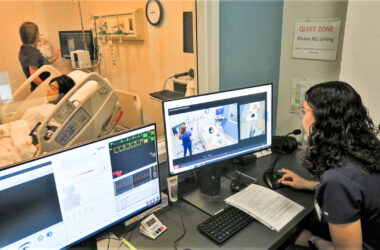For the first time in over a decade, Salem Hospital will turn away some ambulances when its beds are full, sending patients with non-life threatening problems to other hospitals for care.
The hospital announced changes to its divert policy this week, saying diverting ambulances will help manage hospital capacity. The hospital has consistently been close to or over full capacity for the past year.
“While every effort will be made to limit divert, Salem Health is implementing a plan to trigger divert at certain high volume thresholds. Periods of divert will be constantly assessed to keep divert time to a minimum,” Salem Health spokeswoman Lisa Wood said in a statement. “We understand this is a significant change for our community but this decision is consistent with our vision of ‘no patient, employee or provider harm is acceptable to us.’”
The hospital first diverted patients under the new plan on July 26. Diversion lasted less than four hours, Wood said. The hospital does not track how many ambulances are sent elsewhere as a result of the diversion.
Falck, the private ambulance company that serves Salem, learned of the diversion plan July 22, spokesman Jeff Lucia said.
“Diverting (emergency medical service) patients definitely will result in longer ambulance transports to hospitals farther away, and ambulances will take longer to return to their service areas. The health and safety of people in Salem is our top priority. We are prepared to provide advanced care during extended transports, and we are working closely with the fire department to ensure EMS coverage during any diversions,” Lucia said in an email.
Though patients turned away typically have more minor problems, Wood said diversion helps free up adult health and critical care providers to serve the patients already in the hospital.
While hospitals in Portland routinely went on divert status before the pandemic, Salem Hospital has made a point of not doing so because it’s the only hospital in the region equipped to provide higher-level care for some types of medical emergencies. The hospital last diverted patients in 2008.
But over the past year, Salem Hospital has routinely been at or over 100% capacity due to treating a large number of patients with Covid, and other factors that have caused the average length of time patients stay in the hospital to increase. The hospital is licensed for 494 inpatients at a time, though it’s been able to care for more due to federal waivers related to the pandemic.
On Thursday, the hospital had 48 inpatients with Covid, Wood said — nearly two full nursing units.
“While Covid is not the entire reason for (length of stay) increases over the past two years, without the nearly 50 Covid patients alone, it would be much more manageable from a hospital census and cost perspective,” Wood said.
The hospital also continues to have more inpatients who no longer need hospital care but are awaiting a bed in a skilled nursing facility before they can be discharged. Daily, between 40 to 80 patients in the hospital could be discharged if a bed in a nursing facility were available, Wood said.
The decision to divert ambulances is made by a hospital team monitoring real-time data about hospital capacity and staffing, Wood said.
A “statewide decrease in both staffing and services by other providers has signaled the need for certain measures to be put in place to manage hospital capacity. Our Adult Health and Critical Care unit volume continues to be unusually high. In the last month, we have been over 100% occupied, 100% of the time,” she said.
A spokeswoman for Legacy Health, which runs Legacy Silverton Medical Center, did not respond to a question Thursday about how the diversion plan would impact their operations.
Santiam Hospital’s chief medical officer, Dr. Steve Vets, said when Salem Hospital diverts patients, it quickly fills up smaller regional hospitals.
“They are huge compared to us. They’re a swimming pool and we’re a teacup,” he said of Salem Hospital. “When they overflow and go on divert, it fulls us up pretty much instantaneously.”
Vets said he expected if the hospital goes on divert, other regional hospitals like Santiam will have to go on divert soon after because they won’t be able to accommodate more patients.
“It is an admission that their system can’t tolerate any more stress more than it’s actually a meaningful intervention,” Vets said.
But he said he can’t criticize the hospital’s emergency room for making the decision.
“They have been fighting heroically in really challenging conditions for a really long time,” he said. “They’ve been dealing with absolute chaos for months and really years.”
He said Santiam Hospital generally doesn’t go on ambulance diversion, but sometimes has to divert patients with specific needs like a CAT scan if the hospital’s machine is in use. Santiam created a divert plan in response to Salem Hospital’s announcement, he said, so the hospital is able to respond if they become too full to accept new patients.
The decision about whether a patient’s illness or injury is life-threatening is made by the ambulance crew transporting the patient to the hospital, Wood said. Medical providers in the region can see real-time data showing whether the hospital is diverting ambulances through HOSCAP, the state’s hospital capacity system, but there’s no way for the public to view that information, Wood said. She said patients should continue to call 911 for medical emergencies as they have been.
Contact reporter Rachel Alexander: [email protected] or 503-575-1241.
JUST THE FACTS, FOR SALEM – We report on your community with care and depth, fairness and accuracy. Get local news that matters to you. Subscribe to Salem Reporter starting at $5 a month. Click I want to subscribe!

Rachel Alexander is Salem Reporter’s managing editor. She joined Salem Reporter when it was founded in 2018 and covers city news, education, nonprofits and a little bit of everything else. She’s been a journalist in Oregon and Washington for a decade. Outside of work, she’s a skater and board member with Salem’s Cherry City Roller Derby and can often be found with her nose buried in a book.









